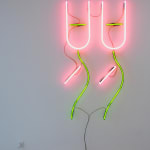Keith Sonnier American, 1941-2020
Further images
Along his contemporaries such as Bruce Nauman, James Turrell, Eva Hesse and Richard Serra, Keith Sonnier (1941 Louisiana, USA - 2020, New York, USA) belongs to a generation of artists who radically changed the common perception of sculpture in the 1960s and paved the way for a genre that is now called installation art.
In 1969, the Documenta curator Harald Szeemann put together the historic exhibition "When Attitudes Become Form" at the Kunsthalle Bern, where Sonnier presented the imprint of a piece of latex on the wall. It was the birth of a new art genre that focused on the processual, the narrative and the sublimation of the momentary: Post-Minimal Art.
One of the best-known of his series is the adaptive light line guidance, which he made part of famous facades: the Kunsthaus Bregenz, Munich Airport, the Neue Nationalgalerie in Berlin. As for his illumination of the National Gallery in Berlin ("Ba-O-Ba"), Sonnier liked to choose fragments of indigenous languages - a return to natural philosophical and ritualistic practice that breathes a post-minimalist romanticism into his formally minimalist compositions.
Sonnier has exhibited in prestigious institutions around the world, including the Centre Pompidou in Paris, the Hirshhorn Museum in Washington, D.C. and his works are not only represented in institutional collections worldwide, but can also still be seen in public places.
As in the Ba-O-Ba series, Sonnier increasingly embraced themes, motifs, and materials from foreign cultures in the early 1980s and combined them with the material aesthetics of Western industrial societies.
Journeys to South America, China, Japan, India, and Southeast Asia changed and expanded Sonnier’s stance toward Western art concepts and thus also toward his own artistic practice. The change of perspective that ensued—including the formal expressions of art forms and cultures unfamiliar to him in his own work—was accompanied by intensive studies of philosophy and the theory of religion. He had already studied anthropology in Louisiana and would later lecture on African art at Rutgers University in New York.
During a trip to China in 1978, Sonnier created the Sel series, which was graphically conceived during the trip and subsequently developed by Sonnier over several years. The works are based on ancient Chinese characters from the 12th century BC. They thus channel both the pictorial nature of writing and the activity of writing or writing movements. The resulting works, such as “TA-SEL”, indeed appear like signs of light and color written into space. Although the arrangements of lines are not aimed at legibility, but rather at a purely physical presence, a special, open kind of sign-like quality is conveyed. Similar to the early form of the Chinese Sel calligraphy, these are images that seem to hold a secret.
In the work, the curved light tubes even transition into the figurative, and to the viewer evoke many associations to floral subject matter. The cables function as lines, but they also have a much more far-reaching function: they hold the respective material structure together. Only the electric circuit supplies the necessary energy to make the gas in the tubes glow.









